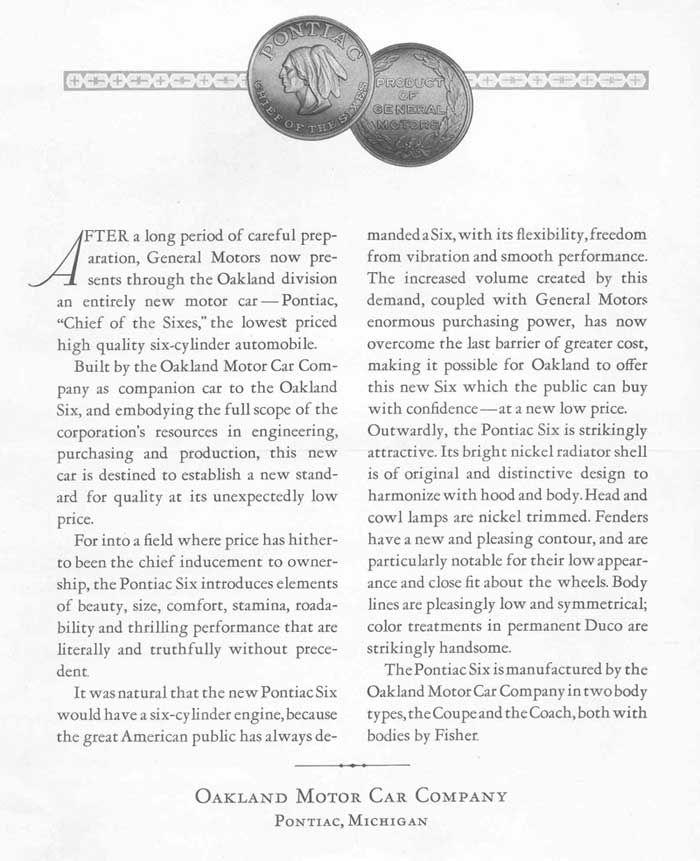

The 1926 Pontiac
The ’26 Pontiac was the result of Alfred P Sloan’s marketing strategy of an automobile for “every purse and purpose” in which he created a distinct hierarchy from the entry-level Chevrolet to the “standard of the world” Cadillac. Sloan created a team to develop the Pontiac concept along with a new 6 cylinder engine; the name and engine were new, the remainder of the Pontiac was conventional General Motors engineering of the day. Chevrolet and Ford were both 4 cylinder automobiles at this time, but buyers definitely preferred the smoothness and additional power of a six. The cheapest Oldsmobile was priced $330 more than the most expensive Chevrolet, hence the reason for the Pontiac. Oakland was charged with producing the new car because the market for expensive 6 cylinder cars had been “soft” for several years and Sloan believed that Oakland dealers would benefit from increased show room traffic with the offering of a lower-priced 6 cylinder model.
The new Pontiac six displaced 186 cubic inches; a relatively large engine for a car priced at $825. It was considered quite unconventional in 1926 for having a bore & stroke of 3 ¼ x 3 ¾ inches; the Oldsmobile 6 was 2 ¾ x 4 ¾. Another unconventional feature was the use of 2 identical cylinder heads, which allowed for the removal of either or both without disturbing the ignition timing, since the distributor was mounted between them. The compression ratio was 4.6:1 and the engine generated 40 horsepower @ 2,400 RPM. At least one source commented on the fact that the large bore and short stroke would effectively reduce internal friction while offering high power output at a relatively low engine speed. This is exactly what GM claimed for the modern overhead valve V-8 engines that Cadillac and Oldsmobile introduced in 1949!
The new Pontiac engine was also equipped with a timing chain as opposed to gear drive for the camshaft; Oldsmobile switched from gear drive to timing chain this year as well. Chains were considered a big improvement over gears; not only were they nearly silent but the reliability was much greater because the working load was spread over a larger surface.
The Pontiac bodies were produced by Fisher and included the “VV” Vision – Ventilation windshield, an automatic windshield wiper and a rear view mirror. The initial models were a coupe and a 2 door, 5 passenger coach. In August of ’26 a 4 door Landau model became available. According to the January 7, 1926 issue of Motor Age; both coupe and coach featured black upper body structures, black fenders and mud guards; the coach body was Arizona gray with red striping while the coupe was light sage green with similar striping. The 4 door Landau was initially offered in Sedge Green with French Gray striping on the body, hood, hood louvers and wheels. The radiator shells were nickel on all models.
The coach featured a dome lamp and both seats tilted forward to allow access to the rear seat area. Gray corduroy upholstery was standard on the coach body and available for the coupe if you didn’t want leather. Instrument panel lighting was indirect for both models.
The ’26 Pontiac models offered significant luxury and performance for the low price of $825 and it’s no wonder that they were a run-away sales success! No other manufacturer could produce such a high quality automobile for so few dollars plus have the production capacity to satisfy the demand. The only failure of Sloan’s plan was that the Pontiac didn’t prevent Oakland from going under; the last models were produced in January of ‘32 and the company officially became Pontiac in June, 1932.
The ’26 Pontiac was the result of Alfred P Sloan’s marketing strategy of an automobile for “every purse and purpose” in which he created a distinct hierarchy from the entry-level Chevrolet to the “standard of the world” Cadillac. Sloan created a team to develop the Pontiac concept along with a new 6 cylinder engine; the name and engine were new, the remainder of the Pontiac was conventional General Motors engineering of the day. Chevrolet and Ford were both 4 cylinder automobiles at this time, but buyers definitely preferred the smoothness and additional power of a six. The cheapest Oldsmobile was priced $330 more than the most expensive Chevrolet, hence the reason for the Pontiac. Oakland was charged with producing the new car because the market for expensive 6 cylinder cars had been “soft” for several years and Sloan believed that Oakland dealers would benefit from increased show room traffic with the offering of a lower-priced 6 cylinder model.
The new Pontiac six displaced 186 cubic inches; a relatively large engine for a car priced at $825. It was considered quite unconventional in 1926 for having a bore & stroke of 3 ¼ x 3 ¾ inches; the Oldsmobile 6 was 2 ¾ x 4 ¾. Another unconventional feature was the use of 2 identical cylinder heads, which allowed for the removal of either or both without disturbing the ignition timing, since the distributor was mounted between them. The compression ratio was 4.6:1 and the engine generated 40 horsepower @ 2,400 RPM. At least one source commented on the fact that the large bore and short stroke would effectively reduce internal friction while offering high power output at a relatively low engine speed. This is exactly what GM claimed for the modern overhead valve V-8 engines that Cadillac and Oldsmobile introduced in 1949!
The new Pontiac engine was also equipped with a timing chain as opposed to gear drive for the camshaft; Oldsmobile switched from gear drive to timing chain this year as well. Chains were considered a big improvement over gears; not only were they nearly silent but the reliability was much greater because the working load was spread over a larger surface.
The Pontiac bodies were produced by Fisher and included the “VV” Vision – Ventilation windshield, an automatic windshield wiper and a rear view mirror. The initial models were a coupe and a 2 door, 5 passenger coach. In August of ’26 a 4 door Landau model became available. According to the January 7, 1926 issue of Motor Age; both coupe and coach featured black upper body structures, black fenders and mud guards; the coach body was Arizona gray with red striping while the coupe was light sage green with similar striping. The 4 door Landau was initially offered in Sedge Green with French Gray striping on the body, hood, hood louvers and wheels. The radiator shells were nickel on all models.
The coach featured a dome lamp and both seats tilted forward to allow access to the rear seat area. Gray corduroy upholstery was standard on the coach body and available for the coupe if you didn’t want leather. Instrument panel lighting was indirect for both models.
The ’26 Pontiac models offered significant luxury and performance for the low price of $825 and it’s no wonder that they were a run-away sales success! No other manufacturer could produce such a high quality automobile for so few dollars plus have the production capacity to satisfy the demand. The only failure of Sloan’s plan was that the Pontiac didn’t prevent Oakland from going under; the last models were produced in January of ‘32 and the company officially became Pontiac in June, 1932.

Jan 13, 1926, First new General Motors Car
The Pontiac Six - presented to Alfred P. Sloan, Jr., president of General Motors Corporation,
by A.R. Clancy, president and general manager of the Oakland Motor Car Company Pontiac, Mich., in New York City.
The Pontiac Six - presented to Alfred P. Sloan, Jr., president of General Motors Corporation,
by A.R. Clancy, president and general manager of the Oakland Motor Car Company Pontiac, Mich., in New York City.
The beginning of our story comes from The First Pontiac by Clark Adams and is used by permission; it appeared in the Piedmont Tri-Power chapter newsletter dated January, 2000.
“The advertisements started appearing in the fall of 1925. On October 3, 1925, an ad appeared in the Saturday Evening Post stating a new General Motors automobile would be produced and distributed by the Oakland division in addition to the present Oakland Six. On January 9, 1926, another advertisement appeared in the Saturday Evening Post in which the name of this new automobile was revealed. It would be called the Pontiac, after, as General Motors put it, “the greatest Indian Chief who ever appeared on the American continent” – renowned leader of the Ottawas, Ojibways, and Pottawattomies.
The car was labeled the “Chief of the Sixes”, referring to its 6-cylinder motor. “To see it will be to experience nothing short of a revelation in quality car design”, stated the ad.
And so began the beginning of our favorite marque. Pontiac production began on December 28, 1925, only six days prior to the first announcements that appeared in the New York Times. Within 12 months a total of 76,742 units would be produced. The car ranked as America’s 13th best selling automobile for the year and generated 49,875 calendar year registrations. The parent of the Pontiac was the Oakland, and in 1925-26, the Oakland was the more expensive car, selling the price range of $1,095 - $1,295. The Pontiac would be the more affordable car. In January, 1926, the new car was debuted at the New Your Automobile Show. After the show, a sales meeting was held at the Commodore Hotel. The hotel was renamed the “Wigwam” for the meeting, the conference was referred to as the “Pow-Wow”, and “Heap Big Eats” was being served for lunch. The car established a maiden sales record beating out Chrysler’s introduction in 1924.”
“The advertisements started appearing in the fall of 1925. On October 3, 1925, an ad appeared in the Saturday Evening Post stating a new General Motors automobile would be produced and distributed by the Oakland division in addition to the present Oakland Six. On January 9, 1926, another advertisement appeared in the Saturday Evening Post in which the name of this new automobile was revealed. It would be called the Pontiac, after, as General Motors put it, “the greatest Indian Chief who ever appeared on the American continent” – renowned leader of the Ottawas, Ojibways, and Pottawattomies.
The car was labeled the “Chief of the Sixes”, referring to its 6-cylinder motor. “To see it will be to experience nothing short of a revelation in quality car design”, stated the ad.
And so began the beginning of our favorite marque. Pontiac production began on December 28, 1925, only six days prior to the first announcements that appeared in the New York Times. Within 12 months a total of 76,742 units would be produced. The car ranked as America’s 13th best selling automobile for the year and generated 49,875 calendar year registrations. The parent of the Pontiac was the Oakland, and in 1925-26, the Oakland was the more expensive car, selling the price range of $1,095 - $1,295. The Pontiac would be the more affordable car. In January, 1926, the new car was debuted at the New Your Automobile Show. After the show, a sales meeting was held at the Commodore Hotel. The hotel was renamed the “Wigwam” for the meeting, the conference was referred to as the “Pow-Wow”, and “Heap Big Eats” was being served for lunch. The car established a maiden sales record beating out Chrysler’s introduction in 1924.”
